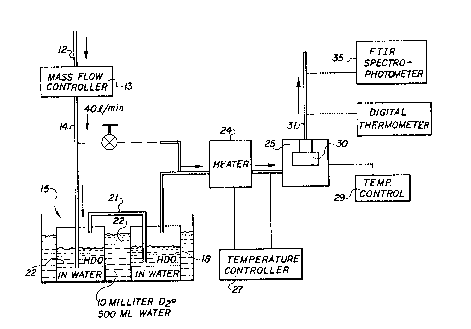Some of the information on this Web page has been provided by external sources. The Government of Canada is not responsible for the accuracy, reliability or currency of the information supplied by external sources. Users wishing to rely upon this information should consult directly with the source of the information. Content provided by external sources is not subject to official languages, privacy and accessibility requirements.
Any discrepancies in the text and image of the Claims and Abstract are due to differing posting times. Text of the Claims and Abstract are posted:
| (12) Patent: | (11) CA 2011500 |
|---|---|
| (54) English Title: | DEUTERATED WATER TEST METHOD |
| (54) French Title: | METHODE D'ESSAI UTILISANT L'EAU DEUTEREE |
| Status: | Expired and beyond the Period of Reversal |
| (51) International Patent Classification (IPC): |
|
|---|---|
| (72) Inventors : |
|
| (73) Owners : |
|
| (71) Applicants : |
|
| (74) Agent: | BORDEN LADNER GERVAIS LLP |
| (74) Associate agent: | |
| (45) Issued: | 1998-02-24 |
| (22) Filed Date: | 1990-03-05 |
| (41) Open to Public Inspection: | 1990-12-26 |
| Examination requested: | 1995-09-26 |
| Availability of licence: | N/A |
| Dedicated to the Public: | N/A |
| (25) Language of filing: | English |
| Patent Cooperation Treaty (PCT): | No |
|---|
| (30) Application Priority Data: | ||||||
|---|---|---|---|---|---|---|
|
A method for testing for the removal of
tritiated water using deuterated water in which the
infrared absorption spectra of deuterated water in an
effluent stream passing through a tritiated water
filtering media is measured.
Méthode pour évaluer l'élimination d'eau tritiée faisant appel à l'utilisation d'eau deutérée dans laquelle le spectre d'absorption infrarouge de l'eau deutérée dans un effluent passant à travers un milieu filtrant à eau tritiée est mesuré.
Note: Claims are shown in the official language in which they were submitted.
Note: Descriptions are shown in the official language in which they were submitted.

2024-08-01:As part of the Next Generation Patents (NGP) transition, the Canadian Patents Database (CPD) now contains a more detailed Event History, which replicates the Event Log of our new back-office solution.
Please note that "Inactive:" events refers to events no longer in use in our new back-office solution.
For a clearer understanding of the status of the application/patent presented on this page, the site Disclaimer , as well as the definitions for Patent , Event History , Maintenance Fee and Payment History should be consulted.
| Description | Date |
|---|---|
| Time Limit for Reversal Expired | 2007-03-05 |
| Inactive: IPC from MCD | 2006-03-11 |
| Letter Sent | 2006-03-06 |
| Grant by Issuance | 1998-02-24 |
| Inactive: Final fee received | 1997-11-21 |
| Pre-grant | 1997-11-21 |
| Notice of Allowance is Issued | 1997-08-11 |
| Notice of Allowance is Issued | 1997-08-11 |
| Letter Sent | 1997-08-11 |
| Inactive: Application prosecuted on TS as of Log entry date | 1997-08-06 |
| Inactive: Status info is complete as of Log entry date | 1997-08-06 |
| Inactive: First IPC assigned | 1997-07-23 |
| Inactive: IPC removed | 1997-07-23 |
| Inactive: IPC assigned | 1997-07-23 |
| Inactive: Approved for allowance (AFA) | 1997-07-23 |
| Request for Examination Requirements Determined Compliant | 1995-09-26 |
| All Requirements for Examination Determined Compliant | 1995-09-26 |
| Application Published (Open to Public Inspection) | 1990-12-26 |
There is no abandonment history.
| Fee Type | Anniversary Year | Due Date | Paid Date |
|---|---|---|---|
| Request for examination - standard | 1995-09-26 | ||
| Final fee - standard | 1997-11-21 | ||
| MF (patent, 8th anniv.) - standard | 1998-03-05 | 1998-03-04 | |
| MF (patent, 9th anniv.) - standard | 1999-03-05 | 1999-02-01 | |
| MF (patent, 10th anniv.) - standard | 2000-03-06 | 2000-02-04 | |
| MF (patent, 11th anniv.) - standard | 2001-03-05 | 2001-02-08 | |
| MF (patent, 12th anniv.) - standard | 2002-03-05 | 2002-02-04 | |
| MF (patent, 13th anniv.) - standard | 2003-03-05 | 2003-02-03 | |
| MF (patent, 14th anniv.) - standard | 2004-03-05 | 2003-12-31 | |
| MF (patent, 15th anniv.) - standard | 2005-03-07 | 2005-02-09 |
Note: Records showing the ownership history in alphabetical order.
| Current Owners on Record |
|---|
| MINE SAFETY APPLIANCES COMPANY |
| Past Owners on Record |
|---|
| RONALD EDWARD THOMPSON |
| WILLIAM PORTER KING |